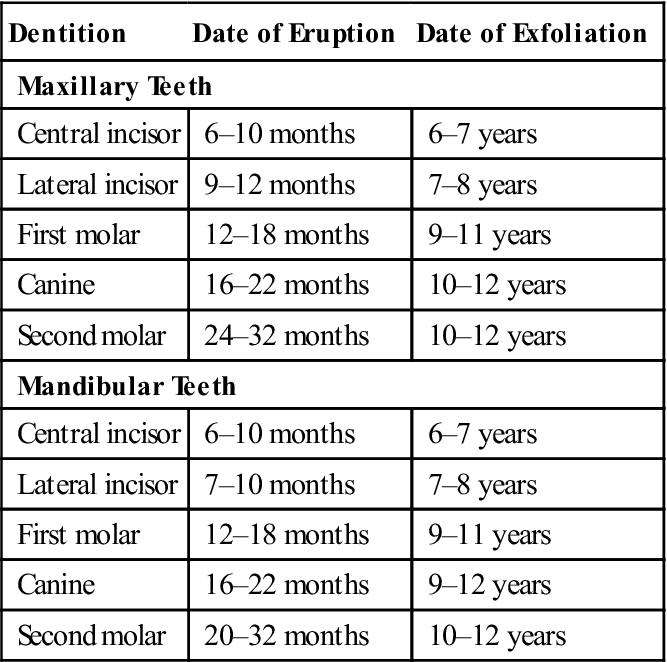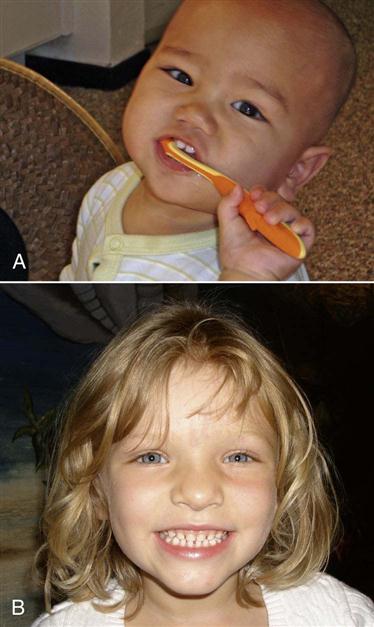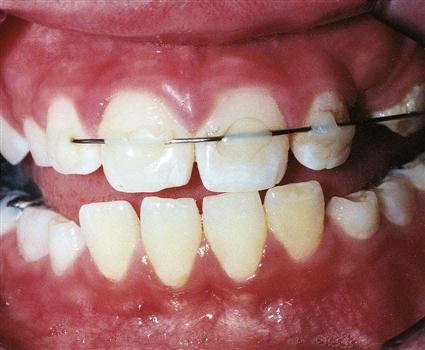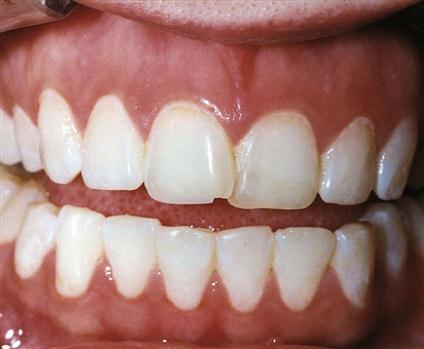Overview of the Dentitions
Learning Outcomes
On completion of this chapter, the student will be able to achieve the following objectives:
• Pronounce, define, and spell the Key Terms.
• Explain how the size and shape of teeth determine the functions of different types of teeth.
• Name and identify the location of each tooth surface.
• Use appropriate terminology to identify landmarks of the teeth.
• Explain the differences between primary, mixed, and permanent dentitions.
• Explain the terms occlusion, centric occlusion, and malocclusion.
• Explain Angle’s classification of malocclusion.
• Name and describe the three primary systems of tooth numbering.
Electronic Resources
![]() Additional information related to content in Chapter 11 can be found on the companion Evolve Web site.
Additional information related to content in Chapter 11 can be found on the companion Evolve Web site.
Key Terms
Angle’s classification System developed by Dr. Edward H. Angle to describe and classify occlusion and malocclusion.
Anterior Toward the front.
Apical third Division of the root nearest the tip of the root.
Buccal surface Tooth surface closest to the inner cheek.
Buccolingual division Lengthwise division of the crown in a labial or buccolingual direction, consisting of the facial or buccal/labial third, middle third, and lingual third.
Centric occlusion Maximum contact between the occluding surfaces of the maxillary and mandibular teeth.
Cervical third Division of the root nearest the neck of the tooth.
Concave Curved inward.
Contact area Area of the mesial or distal surface of a tooth that touches the adjacent tooth in the same arch.
Convex Curved outward.
Curve of Spee Curvature formed by the maxillary and mandibular arches in occlusion.
Curve of Wilson Cross-arch curvature of the occlusal plane.
Deciduous (duh-SID-yoo-us) Pertaining to first dentition of 20 teeth; often called “baby teeth” or primary teeth.
Dentition (den-TI-shun) Natural teeth in the dental arch.
Distal surface Surface of tooth distant from the midline.
Distoclusion (DIS-toe-kloo-shun) A class II malocclusion in which the mesiobuccal cusp of the maxillary first molar occludes (by more than the width of a premolar) mesial to the mesiobuccal groove of the mandibular first molar.
Embrasure (em-BRAY-zhur) Triangular space in a gingival direction between the proximal surfaces of two adjoining teeth in contact.
Functional occlusion Contact of the teeth during biting and chewing movements.
Incisal surface Chewing surface of anterior teeth.
Interproximal (in-tur-PROK-si-mul) space The area between adjacent tooth surfaces.
Labial surface Facial surface closest to the lips.
Line angle Junction of two walls in a cavity preparation.
Lingual surface Surface of mandibular and maxillary teeth closest to the tongue; also called palatal surface.
Linguoversion Position in which the maxillary incisors are behind the mandibular incisors.
Malocclusion (MAL-o-kloo-zhun) Occlusion that is deviated from a class I normal occlusion.
Mandibular (man-DIB-you-ler) arch The lower jaw.
Masticatory (MAS-ti-kuh-tor-ee) surface The chewing surface of the teeth.
Maxillary (MAK-si-lar-ee) arch The upper jaw.
Mesial surface Surface of the tooth toward the midline.
Mesioclusion (MEE-zee-oe-kloo-zhun) Term used for class III malocclusion.
Mesiodistal division Lengthwise division of the crown in a mesiodistal (front-to-back) direction, consisting of the mesial third, middle third, and distal third.
Middle third Division of the root in the middle.
Mixed dentition A mixture of permanent teeth and primary teeth that occurs until all primary teeth have been lost, usually between the ages of 6 and 12.
Neutroclusion An ideal mesiodistal relationship between the jaws and the dental arches.
Occlusal surface Chewing surface of posterior teeth.
Occlusion (oe-KLOO-zhun) The natural contact of the maxillary and mandibular teeth in all positions.
Occlusocervical division Crosswise division of the crown that is parallel to the occlusal or incisal surface, consisting of the occlusal third, middle third, and cervical third.
Palatal surface Lingual surface of maxillary teeth.
Permanent dentition The set of 32 secondary teeth.
Point angle Angle formed by the junction of three surfaces.
Posterior Toward the back.
Primary dentition The first set of 20 primary teeth.
Proximal surfaces The surfaces next to each other when teeth are adjacent in the arch.
Quadrant One quarter of the dentition.
Sextant One sixth of the dentition.
Succedaneous (suk-se-DAY-nee-us) teeth Permanent teeth that replace primary teeth.
In this chapter, you will learn the names and locations of various types of teeth in the human dentition. You will also learn their functions and how they relate to each other in the same dental arch and to teeth in the opposing arch. In preparation for learning dental charting, you will learn the common systems of tooth numbering, as well as the patterns of tooth eruption.
Dentition Periods
During a lifetime, people have two sets of teeth: the primary dentition and the permanent dentition. Dentition describes the natural teeth in the dental arch. Although only two sets of teeth develop, three dentition periods have been identified. These periods are primary, mixed, and permanent.
The first set of 20 primary teeth is called the primary dentition, commonly referred to as the “baby teeth.” You may also hear the term deciduous dentition. This is an older dental term that is less frequently used to describe the primary dentition.
The permanent dentition refers to the 32 secondary teeth, or “adult teeth.” The permanent teeth that replace the primary teeth are called succedaneous teeth, meaning that these teeth “succeed” (come after) deciduous teeth. Because 20 primary teeth are present, 20 succedaneous teeth have also been noted. Molars are not succedaneous teeth because premolars replace the primary molars.
The mixed dentition period takes place between the ages of about 6 and 12 years. Until a child is about 6 years old, the primary dentition is in place. At about that age, the first permanent teeth begin to emerge into the mouth, and there is a mixture of permanent teeth and primary teeth until about age 12, when all primary teeth have been lost (Table 11-1).
TABLE 11-1
Dentition Periods and Clinical Considerations
< ?comst?>
| Dentition Period | Approximate Time Span | Teeth Marking Start of Period | Dentition Present | Growth of Jawbones |
| Primary dentition period | 6 months to 6 years | Eruption of primary mandibular central incisor | Primary | Beginning |
| Mixed dentition | 6 years to 12 years | Eruption of permanent mandibular first molar | Primary and permanent | Fastest and most noticeable |
| Permanent dentition period | After 12 years | Shedding of primary maxillary second molar | Usually permanent | Slowest and least noticeable |
< ?comen?>< ?comst1?>

< ?comst1?>
< ?comen1?>
Adapted from Bath-Balogh M, Fehrenbach MJ: Illustrated dental embryology, histology, and anatomy, ed 3, St Louis, 2011, Saunders; Nelson SJ, Ash MM: Wheeler’s dental anatomy, physiology, and occlusion, ed 9, St Louis, 2010, Saunders.
Primary Dentition
Only primary teeth are present in the mouth during the primary dentition period. This period occurs between approximately 6 months and 6 years of age (Table 11-2). The primary dentition period begins with the eruption of the primary mandibular central incisors and ends when the first permanent mandibular molar erupts (Fig. 11-1).
TABLE 11-2
Primary Dentition in Order of Eruption
< ?comst?>
| Dentition | Date of Eruption | Date of Exfoliation |
| Maxillary Teeth | ||
| Central incisor | 6–10 months | 6–7 years |
| Lateral incisor | 9–12 months | 7–8 years |
| First molar | 12–18 months | 9–11 years |
| Canine | 16–22 months | 10–12 years |
| Second molar | 24–32 months | 10–12 years |
| Mandibular Teeth | ||
| Central incisor | 6–10 months | 6–7 years |
| Lateral incisor | 7–10 months | 7–8 years |
| First molar | 12–18 months | 9–11 years |
| Canine | 16–22 months | 9–12 years |
| Second molar | 20–32 months | 10–12 years |
< ?comen?>< ?comst1?>

< ?comst1?>
< ?comen1?>
Mixed Dentition
While in the mixed dentition period, children lose their primary teeth, and permanent teeth begin to erupt. During this period, children have both primary and permanent teeth in their mouth (Fig. 11-2). The mixed dentition period begins with the eruption of the first permanent tooth and ends with the shedding of the last primary tooth.
The mixed dentition period is often a difficult time for children because color differences between the primary and permanent teeth become apparent (primary teeth are whiter than permanent teeth), and they may notice the difference in crown size between larger permanent teeth and smaller primary teeth. Some children may notice crowding of the teeth as they shift positions during eruption.
Decisions regarding dental treatment are often based on the dentition period. For example, orthodontic treatment may be started or delayed because of anticipated growth and expansion of the jawbones and movement of the teeth. Children experience noticeable changes in their facial contours as the jawbones begin to grow to accommodate the larger permanent teeth.
Permanent Dentition
The permanent dentition is adult dentition (Fig. 11-3). This period begins at about 12 years of age when the last primary tooth is shed (Table 11-3).
TABLE 11-3
Permanent Dentition in Order of Eruption
< ?comst?>
| Dentition | Eruption Date |
| Maxillary Teeth | |
| First molar | 6–7 years |
| Central incisor | 7–8 years |
| Lateral incisor | 8–9 years |
| First premolar | 10–11 years |
| Second premolar | 10–12 years |
| Canine | 11–12 years |
| Second molar | 12–13 years |
| Third molar | 17–21 years |
| Mandibular Teeth | |
| First molar | 6–7 years |
| Central incisor | 6–7 years |
Stay updated, free dental videos. Join our Telegram channel

VIDEdental - Online dental courses





